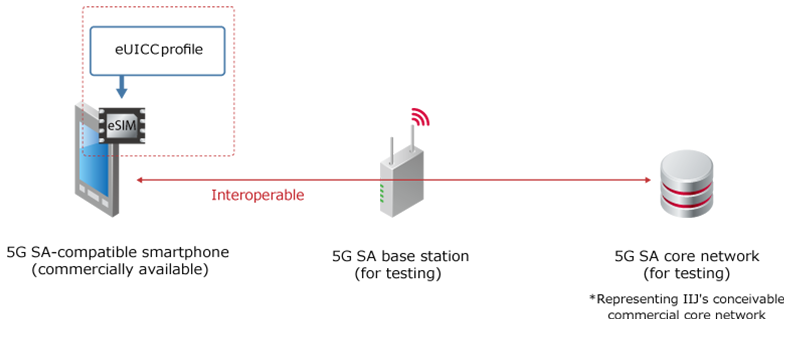Top of Page
- Links to move inside this page.
- HOME
- About IIJ
- News / CSR
- Press Releases
- 2020
- IIJ to Develop Japan's First 5G SA-Compatible eSIM
IIJ to Develop Japan's First 5G SA-Compatible eSIM
Establishing the essential technologies needed for full MVNO and local 5G services, beyond the 5G core networks technologies
November 02, 2020
TOKYO-November 02, 2020-Internet Initiative Japan Inc. (TSE1: 3774), one of Japan's leading Internet access and comprehensive network solutions providers, today announced that it has developed and completed operational trials for Japan's first eSIM that is compatible with 5G standalone (SA), the upcoming mainstream 5G mobile communications.
Since March 2018, IIJ has been offering its mobile communication services as a Japan's first full MVNO. As part of these services, it began providing mobile data services with e-SIM in July 2019. It is currently developing and testing core network technologies for 5G SA, with an eye toward business expansion in local 5G (*1) applications.
IIJ's trial to download the GSMA(*2) certifiled eSIM-which installs eUICC (*3) profile with 5G SA compliance, as standardized by 3GPP, (*4) -to commercially available 5G SA-compliant smartphones confirmed to work well in operational testing environment of 5G SA base stations and a 5G SA core network. IIJ is the first operator in Japan to complete the development and testing of a 5G SA-compatible eSIM (based on IIJ's findings).
With this achievement, IIJ has established the essential technologies required to provide 5G SA services as full MVNO (*5) and local 5G services using a 5G core network.

- (*1)Local 5G: These 5G radio networks (private networks) are allocated and operated by users themselves such as enterprises and autonomies, unlike the 5G networks (public networks) held by mobile network operators nationwide. IIJ develops solutions to help its users operate their local 5G networks.
- (*2)GSM Association (GSMA): The world's largest association of mobile industry. More than 750 carriers and 400 handset and telecommunications equipment manufacturers are members.
- (*3)eUICC: A SIM card with remote provisioning capability (mostly embedded). It can store multiple profiles.
- (*4)3rd Generation Partnership Project (3GPP): The project was established in 1998 to establish third-generation mobile communication standards. Its members include standardization organizations from Europe, the United States, Japan, South Korea, China, and India.
- (*5)A full MVNO platform in 4G and 5G NSA, and also expected and equivalent platform in 5G SA.
Developmental background
The 5G that carriers are now deploying are called non-standalone (NSA). They are structured on systems that add 5G base stations to the existing 4G core network. A 5G NSA system requires the existence of 4G core and radio networks in addition to 5G base stations, which results in an overlapped investment, burdening the local 5G operators seeking to introduce a 5G NSA system. In contrast, 5G SA systems enable standalone 5G base stations without relying on 4G's. Furthermore, when compared to 5G NSA systems, which are characterized solely by Ultra Mobile Broadband, 5G SA systems allow users to benefit from the inherent performance of 5G, which includes ultra-reliable and low latency communications, massive machine type communications in addition to Ultra Mobile Broadband, when combined with 5G next-generation core (NGC) infrastructure. As a result, local 5G will be expected to deploy rapidly with introduction of 5G SA systems.
As a full MVNO, IIJ has been working with SIM card vendor Giesecke+Devrient Mobile Security GmbH to develop, ahead of the competition, a 5G SA-compatible eSIM for the market. The development of the new eSIM introduces a subscription concealed identifier (SUCI), which encrypts the subscriber permanent identifier (SUPI) stored on the SIM card, to enhance security in response to the new standards for 5G SA.
Future developments
IIJ anticipates that the 5G SA-enabled eSIMs will be applicable to services offered on its full MVNO platform and applications for IoT/M2M on local 5G networks. IIJ will help its customers adopt local 5G networks in fields with a promising future, such as factories, warehouses, medical facilities, and etc.
With the completion of 5G SA support for the eSIMs that connect to the 5G core networks, IIJ will be ready to support 5G as soon as the compatible devices and terminals become commercially available. It is also preparing to provide 5G full MVNO and local 5G services, as well as IoT services based on these.
IIJ will also promote 5G SA support for physical, plastic SIM cards in the future.
Endorsement
As the leading global provider of eSIM management solutions, Giesecke+Devrient is proud to provide IIJ 5G SA-compliant eSIM management service, allowing connectivity for new 5G only devices in Japan. G+D is pleased to support IIJ endeavor continuously as their trusted solution partner.
Mario Feuerer
Global Vice President
Giesecke+Devrient Mobile Security GmbH
About IIJ
Founded in 1992, IIJ is one of Japan's leading Internet-access and comprehensive network solutions providers. IIJ and its group companies provide total network solutions that mainly cater to high-end corporate customers. IIJ's services include high-quality Internet connectivity services, systems integration, cloud computing services, security services and mobile services. Moreover, IIJ has built one of the largest Internet backbone networks in Japan that is connected to the United States, the United Kingdom and Asia. IIJ was listed on the First Section of the Tokyo Stock Exchange in 2006.
- For more information about IIJ, visit the IIJ Web site at https://www.iij.ad.jp/en/.
The statements within this release contain forward-looking statements about our future plans that involve risk and uncertainty. These statements may differ materially from actual future events or results.
- For inquiries, contact
-
IIJ Corporate Communications
 +81-3-5205-6310
+81-3-5205-6310  +81-3-5205-6377
+81-3-5205-6377  press@iij.ad.jp
press@iij.ad.jp
- (*)All company, product, and service names used in this press release are the trademarks or registered trademarks of their respective owners.
- Related Contents
End of the page.